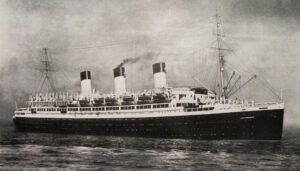
The S.S. Cap Arcona was a German cruise ship during the 20th century. During the Second World War, it was enlisted as a naval vessel, though it also was used as a prop and setting for Goebbels’s movie of the sinking of the R.M.S. Titanic in 1943. As propaganda minister, Goebbels sought to use this film to mock British and American greed and luxuries, but ended up banning the film in Germany after its completion since instead it suggested that the German government was failing much like the sinking ship. The Cap Arcona, however, would continue to a fate even more gruesome than the story she enacted.
By early April 1945, hope began to grow in Nazi concentration camps. Rumors had been going around that Adolf Hitler had taken his life and, with the Allied forces in much of Axis territory, the concentration camp prisoners dared to think that maybe their savior was almost upon them.
In late April, prisoners from three concentrations camps, Neuengamme, Mittelbau-Dora and Stutthof, were marched to the German Baltic coast. While it was an assortment of many “enemies of the third Reich”, the majority of the prisoners were Jews and Russian POWs. The 10,000 prisoners were put onto three ships, Cap Arcona, Thielbeck and Athen. Nearly 5,000 of those prisoners were on the Cap Arcona alone.
Despite the fact that the surrender of Germany was imminent, the British RAF still had missions to carry out. On May 3, four squadrons were assigned to destroy the shipping supplies at the port of Lübeck, where the three ships were docked. At 2:30 in the afternoon, the RAF fired upon the vessels, sinking all of them. If this was not bad enough, German soldiers gunned down any of the prisoners who made it back to shore. Around 7,500 prisoners died from the incident; only 350 survived the bombardment and sinking of the Cap Arcona. It is suspected that the Nazis had planned to sink the ships with the prisoners onboard anyway, but used the routine war operation to their advantage.
Despite being one of the worst maritime loses to date, this event is not very well known due to the post-victory jubilance of the Allies and the outcry for peace and reform in Europe following the war. Many historians and activists have come together to try to piece together the details of the incident to honor its victims so it can be done before the British declassify the documents regarding the incident in 2045. Several monuments in Germany have been raised to honor those wrongfully killed, including on at Lübeck and a beach in Pelzerhaken, where many of the bodies of the victims washed up and were buried.
Back to Crime Library
|
|
|
